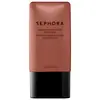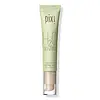What's inside
What's inside
 Key Ingredients
Key Ingredients

 Benefits
Benefits

 Concerns
Concerns

 Ingredients Side-by-side
Ingredients Side-by-side

Water
Skin ConditioningDimethicone
EmollientTalc
AbrasiveCI 77891
Cosmetic ColorantSilica
AbrasiveCetyl PEG/PPG-10/1 Dimethicone
EmulsifyingGlycerin
HumectantNeopentyl Glycol Diheptanoate
EmollientPolymethylsilsesquioxane
Hdi/Trimethylol Hexyllactone Crosspolymer
Isododecane
EmollientPhenoxyethanol
PreservativeSodium Chloride
MaskingEthylene Brassylate
MaskingMagnesium Sulfate
Dimethicone/Vinyl Dimethicone Crosspolymer
Skin ConditioningSodium Dehydroacetate
PreservativeHydrogen Dimethicone
Potassium Sorbate
PreservativeQuaternium-18 Hectorite
Benzoic Acid
MaskingAluminum Hydroxide
EmollientTriethoxycaprylylsilane
CI 77492
Cosmetic ColorantDehydroacetic Acid
PreservativePropylene Carbonate
SolventEthylhexylglycerin
Skin ConditioningCI 77491
Cosmetic ColorantCI 77499
Cosmetic ColorantWater, Dimethicone, Talc, CI 77891, Silica, Cetyl PEG/PPG-10/1 Dimethicone, Glycerin, Neopentyl Glycol Diheptanoate, Polymethylsilsesquioxane, Hdi/Trimethylol Hexyllactone Crosspolymer, Isododecane, Phenoxyethanol, Sodium Chloride, Ethylene Brassylate, Magnesium Sulfate, Dimethicone/Vinyl Dimethicone Crosspolymer, Sodium Dehydroacetate, Hydrogen Dimethicone, Potassium Sorbate, Quaternium-18 Hectorite, Benzoic Acid, Aluminum Hydroxide, Triethoxycaprylylsilane, CI 77492, Dehydroacetic Acid, Propylene Carbonate, Ethylhexylglycerin, CI 77491, CI 77499
Water
Skin ConditioningCyclopentasiloxane
Emollient1,2-Hexanediol
Skin ConditioningHexyl Laurate
EmollientGlycerin
HumectantPEG-10 Dimethicone/Vinyl Dimethicone Crosspolymer
StabilisingRosa Centifolia Flower Water
Skin ConditioningAnthemis Nobilis Flower Extract
MaskingLavandula Angustifolia Extract
Skin ConditioningCamellia Sinensis Leaf Extract
AntimicrobialPortulaca Oleracea Extract
Skin ConditioningTocopherol
AntioxidantDimethicone
EmollientCetyl PEG/PPG-10/1 Dimethicone
EmulsifyingPEG-10 Dimethicone Crosspolymer
StabilisingTriethoxycaprylylsilane
Aluminum Hydroxide
EmollientSodium Chloride
MaskingEthylhexylglycerin
Skin ConditioningCyclotetrasiloxane
EmollientPhenoxyethanol
PreservativeCI 77891
Cosmetic ColorantIron Oxides
Water, Cyclopentasiloxane, 1,2-Hexanediol, Hexyl Laurate, Glycerin, PEG-10 Dimethicone/Vinyl Dimethicone Crosspolymer, Rosa Centifolia Flower Water, Anthemis Nobilis Flower Extract, Lavandula Angustifolia Extract, Camellia Sinensis Leaf Extract, Portulaca Oleracea Extract, Tocopherol, Dimethicone, Cetyl PEG/PPG-10/1 Dimethicone, PEG-10 Dimethicone Crosspolymer, Triethoxycaprylylsilane, Aluminum Hydroxide, Sodium Chloride, Ethylhexylglycerin, Cyclotetrasiloxane, Phenoxyethanol, CI 77891, Iron Oxides
Ingredients Explained
These ingredients are found in both products.
Ingredients higher up in an ingredient list are typically present in a larger amount.
Aluminum Hydroxide is a form of aluminum. It can be naturally found in nature as the mineral gibbsite. In cosmetics, Aluminum Hydroxide is used as a colorant, pH adjuster, and absorbent.
As a colorant, Aluminum Hydroxide may add opacity, or reduce the transparency. Aluminum hydroxide is contains both basic and acidic properties.
According to manufacturers, this ingredient is an emollient and humectant. This means it helps hydrate the skin.
In medicine, this ingredient is used to help relieve heartburn and help heal ulcers.
There is currently no credible scientific evidence linking aluminum hydroxide in cosmetics to increased cancer risk.
Major health organizations allow the use of aluminum hydroxide in personal care products and have not flagged it as a carcinogenic risk at typical usage levels.
Learn more about Aluminum HydroxideThis ingredient is a high molecular weight silicone. It has emulsifying and skin conditioning properties.
Ci 77891 is a white pigment from Titanium dioxide. It is naturally found in minerals such as rutile and ilmenite.
It's main function is to add a white color to cosmetics. It can also be mixed with other colors to create different shades.
Ci 77891 is commonly found in sunscreens due to its ability to block UV rays.
Learn more about CI 77891Dimethicone is a type of synthetic silicone created from natural materials such as quartz.
What it does:
Dimethicone comes in different viscosities:
Depending on the viscosity, dimethicone has different properties.
Ingredients lists don't always show which type is used, so we recommend reaching out to the brand if you have questions about the viscosity.
This ingredient is unlikely to cause irritation because it does not get absorbed into skin. However, people with silicone allergies should be careful about using this ingredient.
Note: Dimethicone may contribute to pilling. This is because it is not oil or water soluble, so pilling may occur when layered with products. When mixed with heavy oils in a formula, the outcome is also quite greasy.
Learn more about DimethiconeEthylhexylglycerin (we can't pronounce this either) is commonly used as a preservative and skin softener. It is derived from glyceryl.
You might see Ethylhexylglycerin often paired with other preservatives such as phenoxyethanol. Ethylhexylglycerin has been found to increase the effectiveness of these other preservatives.
Glycerin is already naturally found in your skin. It helps moisturize and protect your skin.
A study from 2016 found glycerin to be more effective as a humectant than AHAs and hyaluronic acid.
As a humectant, it helps the skin stay hydrated by pulling moisture to your skin. The low molecular weight of glycerin allows it to pull moisture into the deeper layers of your skin.
Hydrated skin improves your skin barrier; Your skin barrier helps protect against irritants and bacteria.
Glycerin has also been found to have antimicrobial and antiviral properties. Due to these properties, glycerin is often used in wound and burn treatments.
In cosmetics, glycerin is usually derived from plants such as soybean or palm. However, it can also be sourced from animals, such as tallow or animal fat.
This ingredient is organic, colorless, odorless, and non-toxic.
Glycerin is the name for this ingredient in American English. British English uses Glycerol/Glycerine.
Learn more about GlycerinPhenoxyethanol is a preservative that has germicide, antimicrobial, and aromatic properties. Studies show that phenoxyethanol can prevent microbial growth. By itself, it has a scent that is similar to that of a rose.
It's often used in formulations along with Caprylyl Glycol to preserve the shelf life of products.
Chances are, you eat sodium chloride every day. Sodium Chloride is also known as table salt.
This ingredient has many purposes in skincare: thickener, emulsifier, and exfoliator.
You'll most likely find this ingredient in cleansers where it is used to create a gel-like texture. As an emulsifier, it also prevents ingredients from separating.
There is much debate on whether this ingredient is comedogenic. The short answer - comedogenic ratings don't tell the whole story. Learn more about comegodenic ratings here.
The concensus about this ingredient causing acne seems to be divided. Research is needed to understand if this ingredient does cause acne.
Scrubs may use salt as the primary exfoliating ingredient.
Learn more about Sodium ChlorideTriethoxycaprylylsilane is a silicone used to bind and stabilize ingredients.
As an emulsifier, it helps prevent ingredients from separating. This can help elongate the shelf life of products.
Triethoxycaprylylsilane is often used to coat mineral sunscreens ingredients to help give a better feel. It also helps reduce oxidative stress in sunscreens.
Learn more about TriethoxycaprylylsilaneWater. It's the most common cosmetic ingredient of all. You'll usually see it at the top of ingredient lists, meaning that it makes up the largest part of the product.
So why is it so popular? Water most often acts as a solvent - this means that it helps dissolve other ingredients into the formulation.
You'll also recognize water as that liquid we all need to stay alive. If you see this, drink a glass of water. Stay hydrated!
Learn more about Water